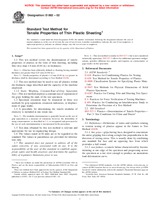Potrebujeme váš súhlas na využitie jednotlivých dát, aby sa vám okrem iného mohli ukazovať informácie týkajúce sa vašich záujmov. Súhlas udelíte kliknutím na tlačidlo „OK“.
ASTM D882-02
Standard Test Method for Tensile Properties of Thin Plastic Sheeting
Automaticky preložený názov:
Štandardná skúšobná metóda pre ťahových vlastností tenkých plastových fólií
NORMA vydaná dňa 10.4.2002
Informácie o norme:
Označenie normy: ASTM D882-02
Poznámka: NEPLATNÁ
Dátum vydania normy: 10.4.2002
Kód tovaru: NS-39591
Počet strán: 9
Približná hmotnosť: 27 g (0.06 libier)
Krajina: Americká technická norma
Kategória: Technické normy ASTM
Anotácia textu normy ASTM D882-02 :
Keywords:
modulus of elasticity, plastic film, plastic sheeting, tensile properties, tensile strength, toughness, yield stress, ICS Number Code 71.080.99 (Other organic chemicals)
Doplňujúce informácie
| Significance and Use | ||||||||||||||||||||
|
Tensile properties determined by this test method are of value for the identification and characterization of materials for control and specification purposes. Tensile properties may vary with specimen thickness, method of preparation, speed of testing, type of grips used, and manner of measuring extension. Consequently, where precise comparative results are desired, these factors must be carefully controlled. This test method shall be used for referee purposes, unless otherwise indicated in particular material specifications. For many materials, there may be a specification that requires the use of this test method, but with some procedural modifications that take precedence when adhering to the specification. Therefore, it is advisable to refer to that material specification before using this test method. Table 1 in Classification D 4000 lists the ASTM materials standards that currently exist. Tensile properties may be utilized to provide data for research and development and engineering design as well as quality control and specification. However, data from such tests cannot be considered significant for applications differing widely from the load-time scale of the test employed. The tensile modulus of elasticity is an index of the stiffness of thin plastic sheeting. The reproducibility of test results is good when precise control is maintained over all test conditions. When different materials are being compared for stiffness, specimens of identical dimensions must be employed. The tensile energy to break (TEB) is the total energy absorbed per unit volume of the specimen up to the point of rupture. In some texts this property has been referred to as toughness. It is used to evaluate materials that may be subjected to heavy abuse or that might stall web transport equipment in the event of a machine malfunction in end-use applications. However, the rate of strain, specimen parameters, and especially flaws may cause large variations in the results. In that sense, caution is advised in utilizing TEB test results for end-use design applications. Materials that fail by tearing give anomalous data which cannot be compared with those from normal failure. |
||||||||||||||||||||
| 1. Scope | ||||||||||||||||||||
|
1.1 This test method covers the determination of tensile properties of plastics in the form of thin sheeting, including film (less than 1.0 mm (0.04 in.) in thickness). Note 1—Film has been arbitrarily defined as sheeting having nominal thickness not greater than 0.25 mm (0.010 in.). Note 2—Tensile properties of plastics 1.0 mm (0.04 in.) or greater in thickness shall be determined according to Test Method D638. 1.2 This test method may be used to test all plastics within the thickness range described and the capacity of the machine employed. 1.2.1 Static Weighing, Constant-Rate-of-Grip Separation Test—This test method employs a constant rate of separation of the grips holding the ends of the test specimen. 1.3 Specimen extension may be measured in these test methods by grip separation, extension indicators, or displacement of gage marks. 1.4 A procedure for determining the tensile modulus of elasticity is included at one strain rate. Note 3—The modulus determination is generally based on the use of grip separation as a measure of extension; however, the desirability of using extensometers, as described in 5.2, is recognized and provision for the use of such instrumentation is incorporated in the procedure. 1.5 Test data obtained by this test method is relevant and appropriate for use in engineering design. 1.6 The values stated in SI units are to be regarded as the standard. The values in parentheses are provided for information only. 1.7 This standard does not purport to address all of the safety concerns, if any, associated with its use. It is the responsibility of the user of this standard to establish appropriate safety and health practices and determine the applicability of regulatory limitations prior to use. Note 4—This test method is similar to ISO 527-3, but is not considered technically equivalent. ISO 527-3 allows for additional specimen configurations, specifies different test speeds, and requires an extensometer or gage marks on the specimen. |
||||||||||||||||||||
| 2. Referenced Documents | ||||||||||||||||||||
|




 Cookies
Cookies
